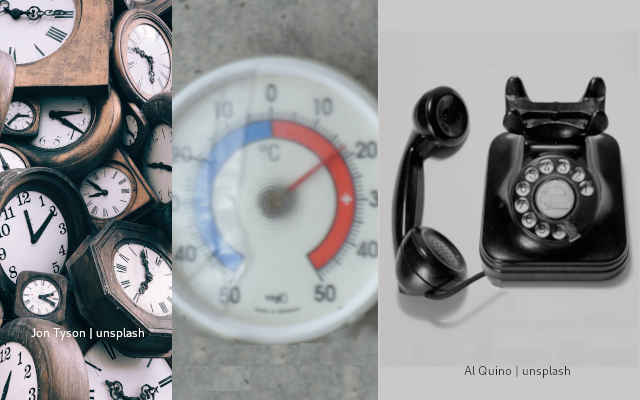As in English, there are several ways of saying the time in German.
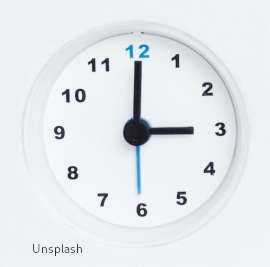
Official time
Official time is used for things like train schedules, store hours, and doctor’s offices. It consists of a two digit hour number, a period, and a two digit minute. It uses a 24-hour clock, so the range of hours is from 00 to 23 as follows:

When saying the official time verbally, substitute “uhr” (o’clock) for the period and leave off the minutes if the minutes are 00. Examples: Der Zug fahrt um dreizhen uhr drei und vierzig los (The train leaves at 1:43 PM). Ich soll da um sechszhen Uhr sein (I should be there at 4:00 PM).
(With all four digits and without the period, it becomes the well-known military time. But you would never say stunden [hours] after the German official time.)
Although a period separating the hours and the minutes is “correct”, I see increasing uses of a colon (:) instead, due to the influence of the USA and other countries.

Fractional time
Fractional time states what portion of an hour has passed before the next whole hour. (The fraction is always quarters and halves, never something exotic like thirds.) Here are the three possibilities:
In the table, 3:15 PM is viertel vier, not viertel drei. This is easy to remember if you think of dreiviertel as meaning a quarter to. You wouldn’t say 10:45 is a quarter to 10, would you?
Fractional time is mostly verbal and colloquial. It uses a 12-hour clock, so the hours run from 1 to 12, not 00 to 23. If there’s any possible confusion about whether you mean AM or PM, add Vormittags (before noon), Nachmittags (after noon), or Abends (evening). Example: Ruf mir um halb neun Abends an (Phone me at 8:30 PM).
If it’s on the hour exactly (or roughly), you can just say it like the above leaving out the fraction. Like ich mache eine pause um zwei (I will take a break at 2).
Relative time
Relative time gives a number of minutes before (vor) or after (nach) the given hour. It also tends to be verbal and colloquial. Examples: acht minuten vor zwölf (11:52) or fünfzhen minuten nach zhen (10:15).
It’s also possible to say kurz to mean a few minutes, as in, der Wetter kommt kurz bevor elf (The weather [report] comes just before 11).
Combined time
This combines fractional and relative time by stating a number of minutes before or after the fraction, as in Ich wache auf fünf minuten nach halb sieben (10:35) or kurz nach fünf (just after 5).
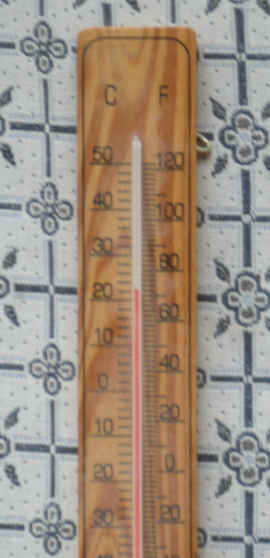
Temperature
Germany is a metric country. That means, among other things, that it uses the Centigrade (also called Celsius) temperature scale. (The alternative, the Fahrenheit scale, is the only scale that the United States uses [plus a few small countries]. The United Kingdom and a few more small countries use both. There are also two other temperature scales, the Kelvin and the Rankine, which are used only in scientific work.)
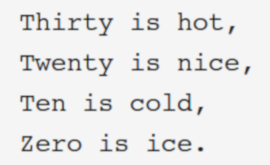
A quick way to understand Centigrade temperatures, for you Fahrenheit users out there, is to remember the ditty shown nearby:
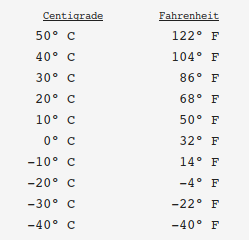
But a more complete table of conversions would look like the adjacent table:
Note that -40° is the SAME on both scales. It always amuses me to see “-40° C” or “-40° F” because at that temperature, it’s both. No need to differentiate.
My mom told me that anything prepared in the oven can be prepared at 375° F. That is very near to 190° C. So today if I don’t know what to set the oven at, I set it for 190° C.
Not body temperature
It’s a common misperception that our bodies must run at a temperature of 37° C or 98.6° F. Actually, normal body temperature is a range centered around those figures. Using the conversion formula to change 37° C to Fahrenheit indeed does result in 98.6, but since normal body temperature is 37° C plus or minus a few tenths, it would be more correct to say normal body temperature in Fahrenheit is from 98° to 99°.
The difficulty comes from the fact that applying the formula throws one extra digit into the result. By displaying one digit past the decimal point, that implies the number is exact to that level of precision.
To this day, when I hear the song “98.6” on the radio, I sing along in German: “hey sieben-und-dreizig“.
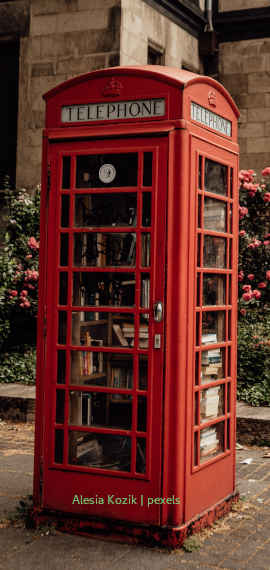
Phone numbers
Phone numbers in a given city are generally six to nine digits long. The easiest to say them is to just speak each digit separately, like drei sechs null eins sieben zwei drei (3601723), although this is normally not done. (When speaking on the phone, people will sometimes substitute zwo for zwei. It means the same thing, and is less likely to be confused with drei.)
More commonly
A more common method is to break the number up into two-digit chunks as in 26 13 82 02. Verbally, say each pair as described here and here, except when the first digit of a pair is 0, when you would say each digit separately anyway. So the above would be sechsundzwansig dreizhen zweiundachtzig null zwei.
Odd number of digits
What if they’re an odd number of digits? You have some flexibility here, but the most usual way is to put three digits in the first group, such as 385 26 22. Say it out loud by pronouncing the 3 as a single digit, then the rest of the number two digits at a time — specifically, drei fünfundachtzig sechsundzwanzig zweiundzwanzig.
But no matter what the number of digits, you can have two or more three-digit groups.
Businesses
Businesses often have a phone number ending in 0 for their general or reception number; and other numbers are the same as the general number, but with the 0 replaced by two or three digits that ring through to specific people. In that case, a hyphen (-) is usually placed between the constant (left) part and the variable (right) part, as in 28 23 64-0 and 28 23 64-128. For the constant part, break the number up as you normally do, ignoring the contribution of the variable part.
City codes
When calling from one number to another within a given city code, you don’t need to dial a city code at all. But when calling from one city code to another, you do. City codes always begin with 0; for example: 0711 is the city code for Stuttgart. When writing down the number, some people put a slash (/) between the city code and the rest; others just use a space. But when breaking up the rest into groups of two or three digits, don’t include the city code in that process.
Cell (mobile) phones
Cell phones have their own city codes, as if each cell phone company is in a city by themselves. This is instead of a “real city” code, not in addition to.
The country code for Germany is 0049
All European country codes begin with is 00. When calling Germany from another country, dial 0049, the city code, and then the rest. But here’s the catch: when dialing the country code AND the city code, drop the initial zero from the city code. So to call Stuttgart from Strasbourg, dial 0049711, then the rest of the number. For this reason, lists of phone numbers usually abbreviate the country code as +49, with the + there to help you remember that you don’t need the country code if calling within Germany, and to drop the first digit of the city code.
And what do I do, personally?
I write the combined country/city code for Stuttgart as (0(049)711). So if calling within Germany, I throw out the (049) leaving (0711). And if calling from within Stuttgart itself, I drop the whole (0(049)711), leaving just the local number.
I’m lazy. I write phone numbers within a city four digits at a time, with any short groups at the end. But that’s just me; do what you think is best.
And I always use spaces to separate groups; never slashes or hyphens.
A final tip
When talking on the phone, telling someone your phone number, always speak very slowly. It’s tempting to rush through it because we know our own phone numbers so well, but the listener really does need for you to slow down.
Look for Jennie’s German Language Classroom for English Speakers on a Wednesday near the end of the month.
Copyright © 2021 by Jennifer Freeman. In particular, permission is not granted to assemble the parts of this series together and distribute them. You may of course post links to the individual posts.
